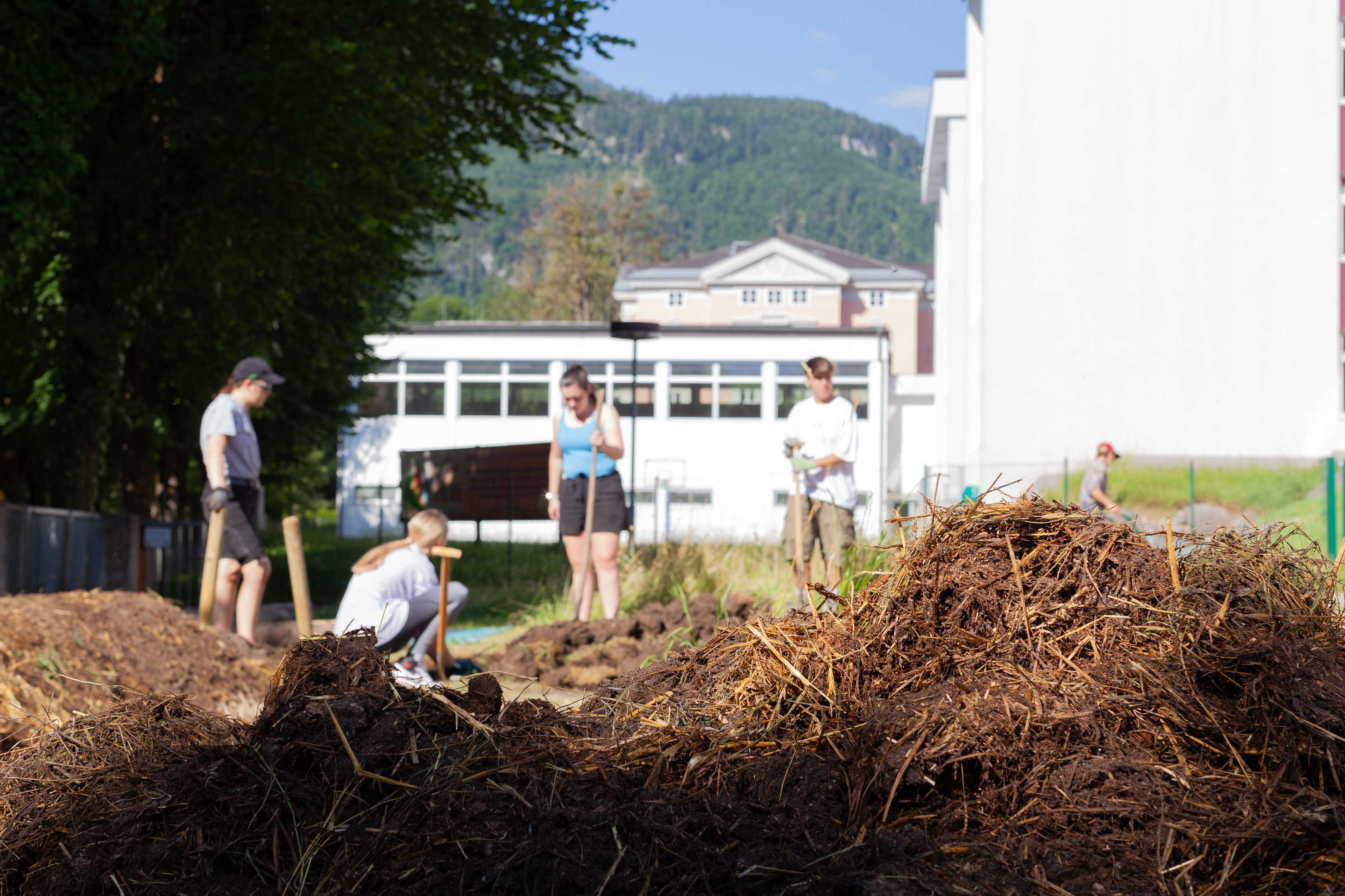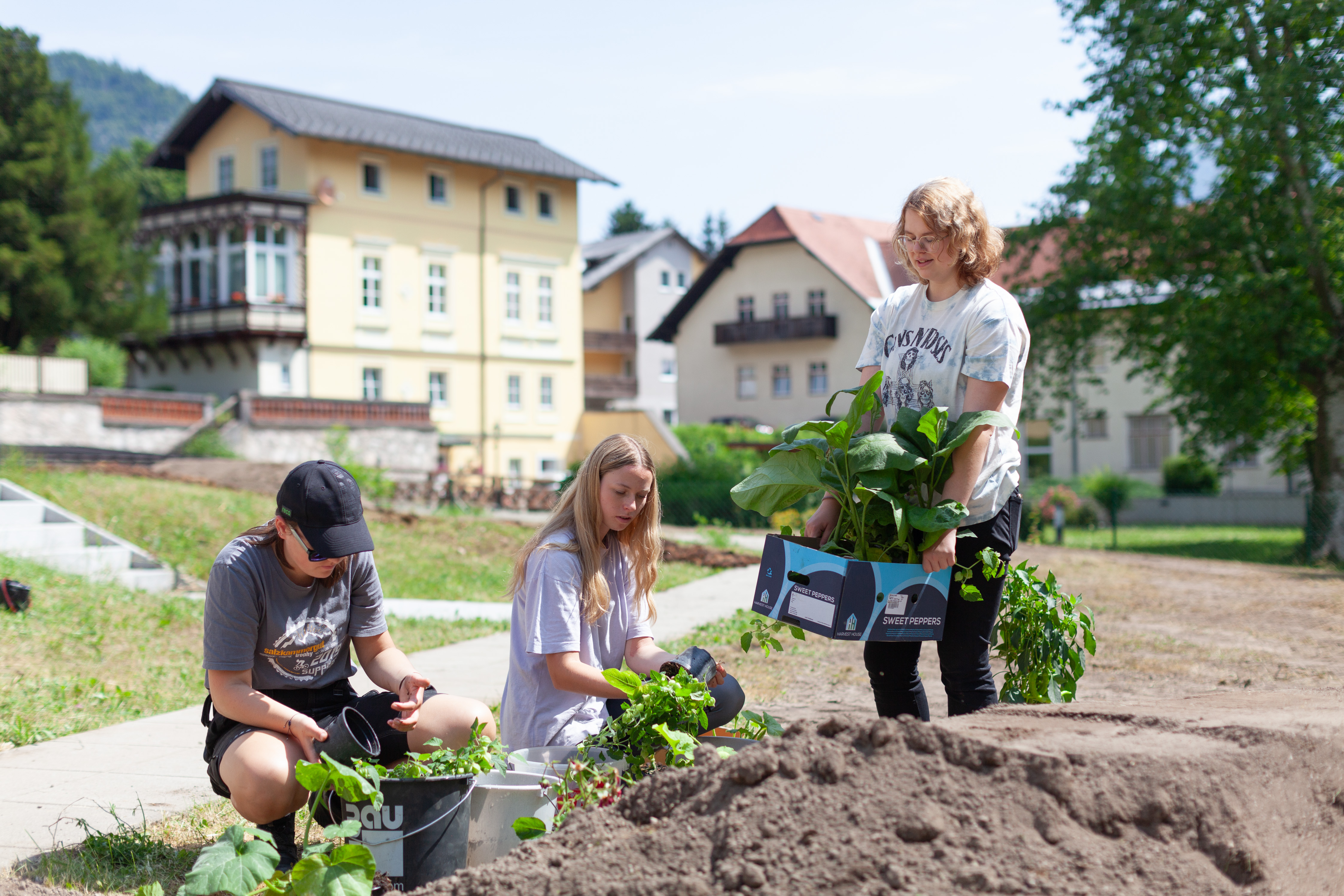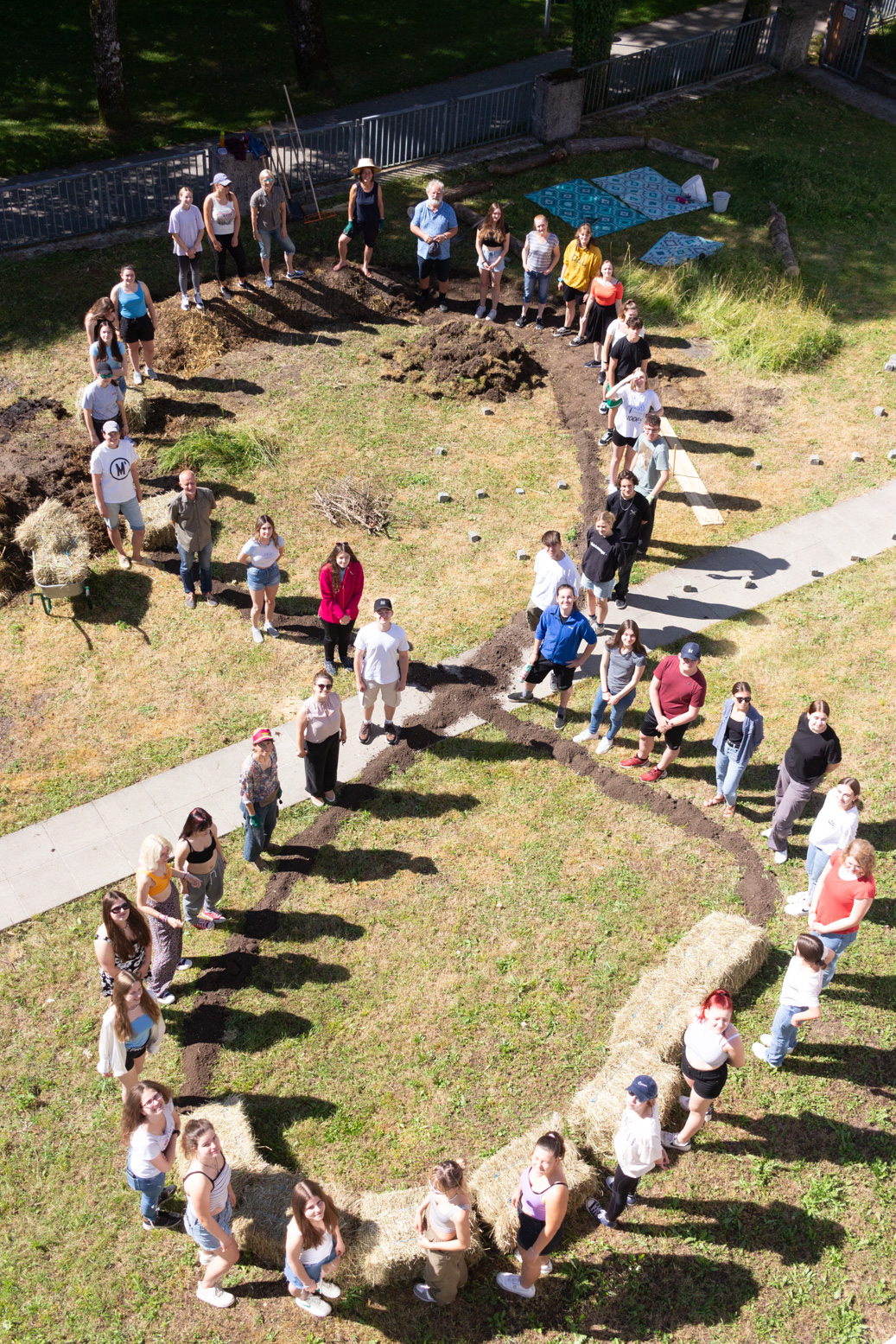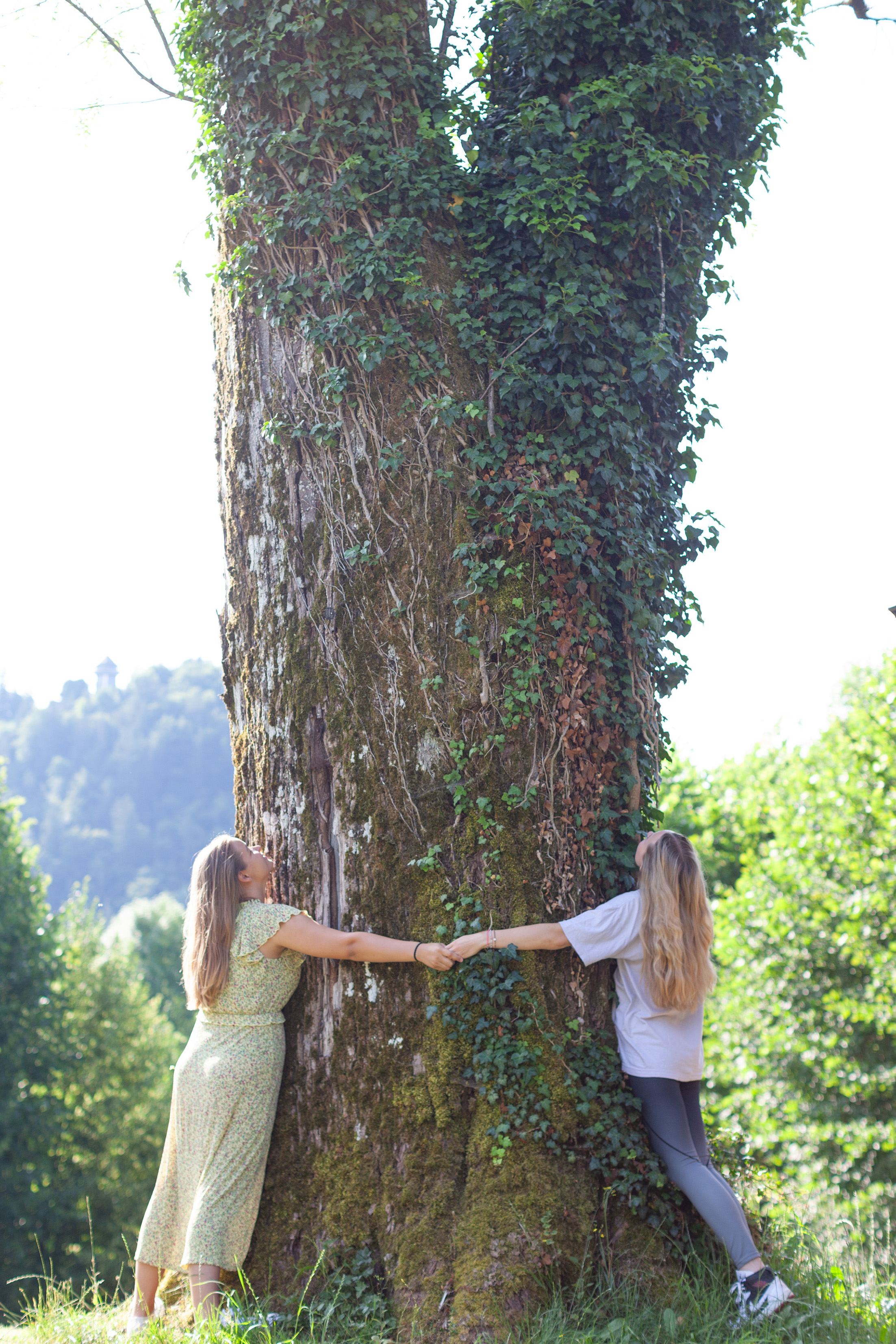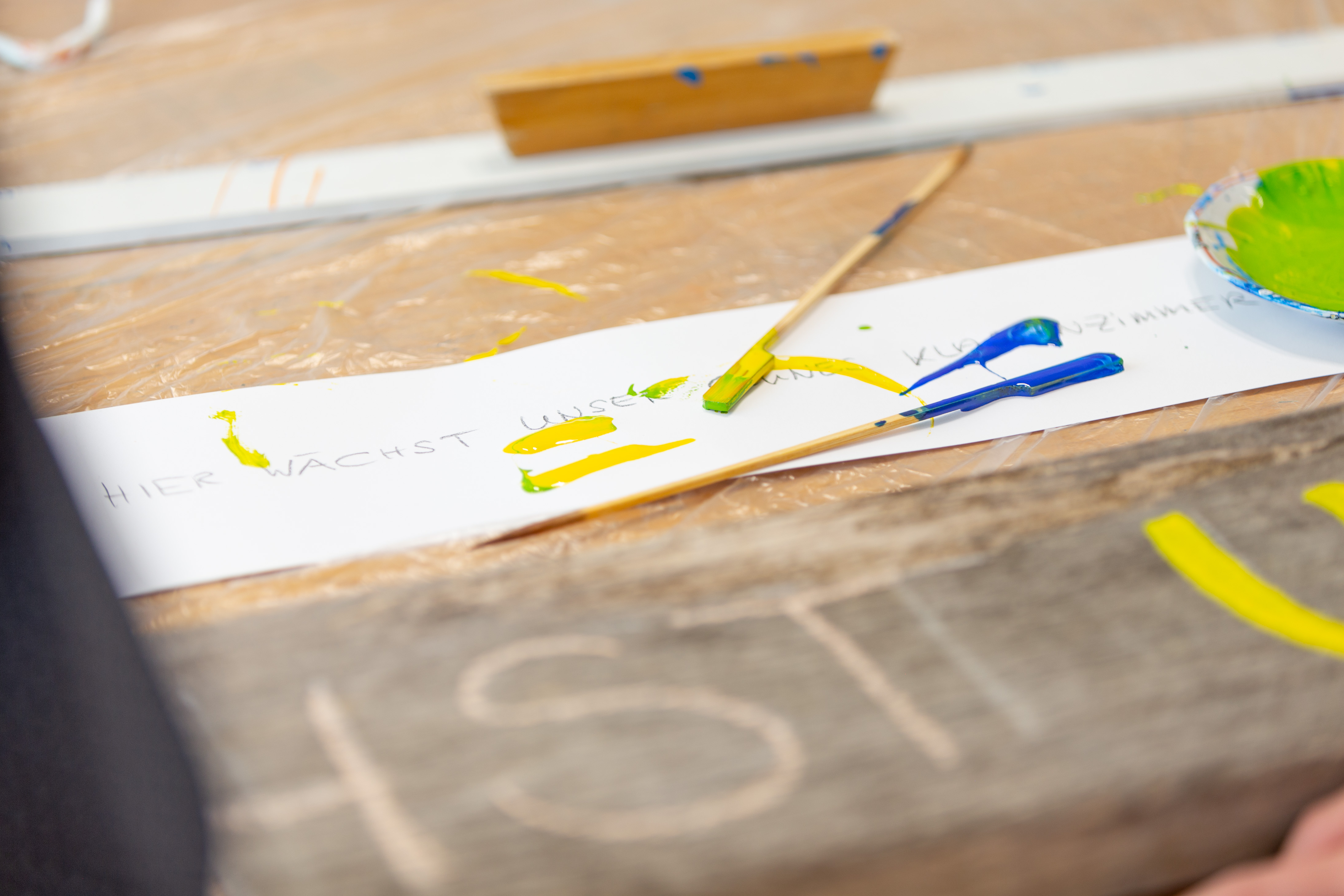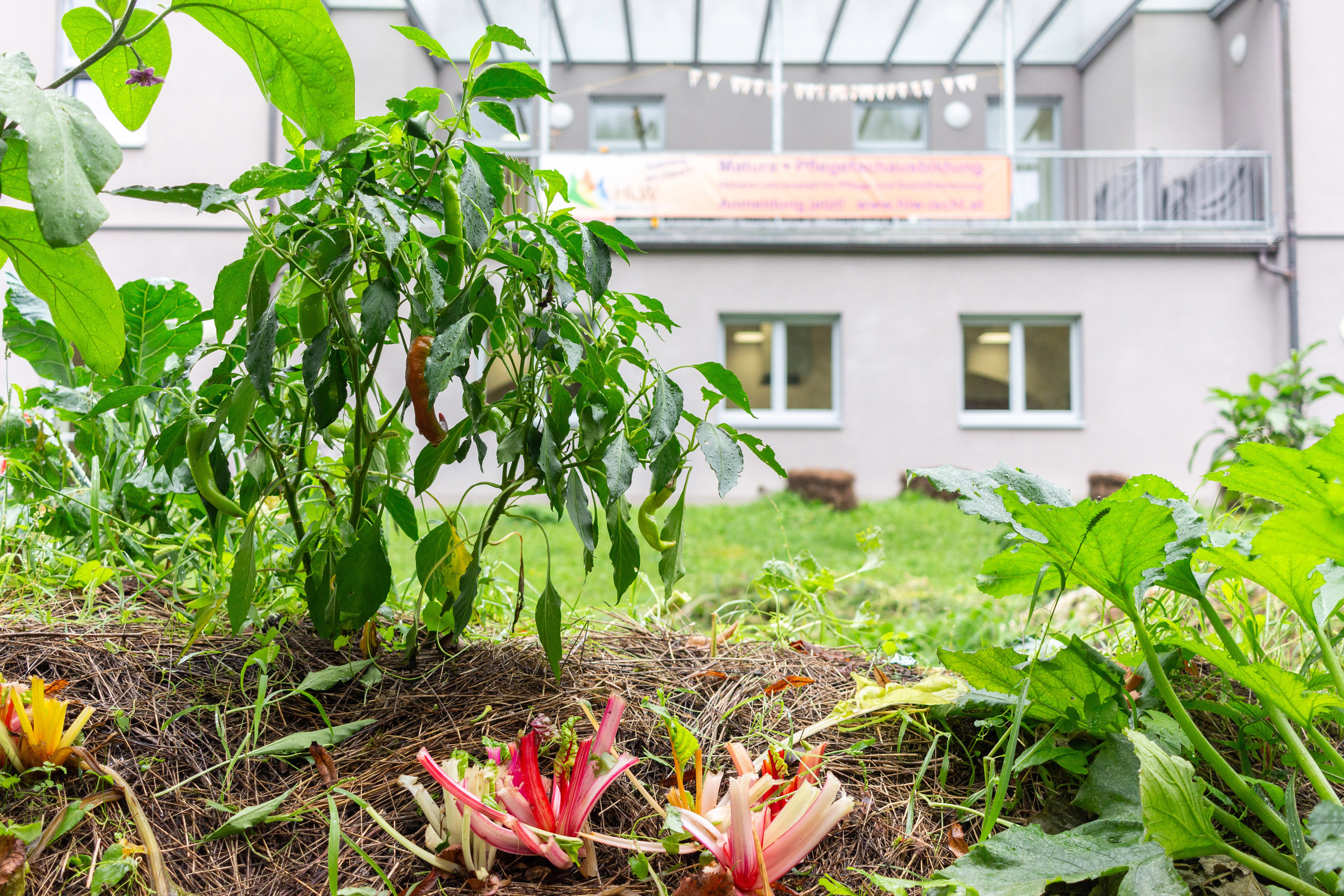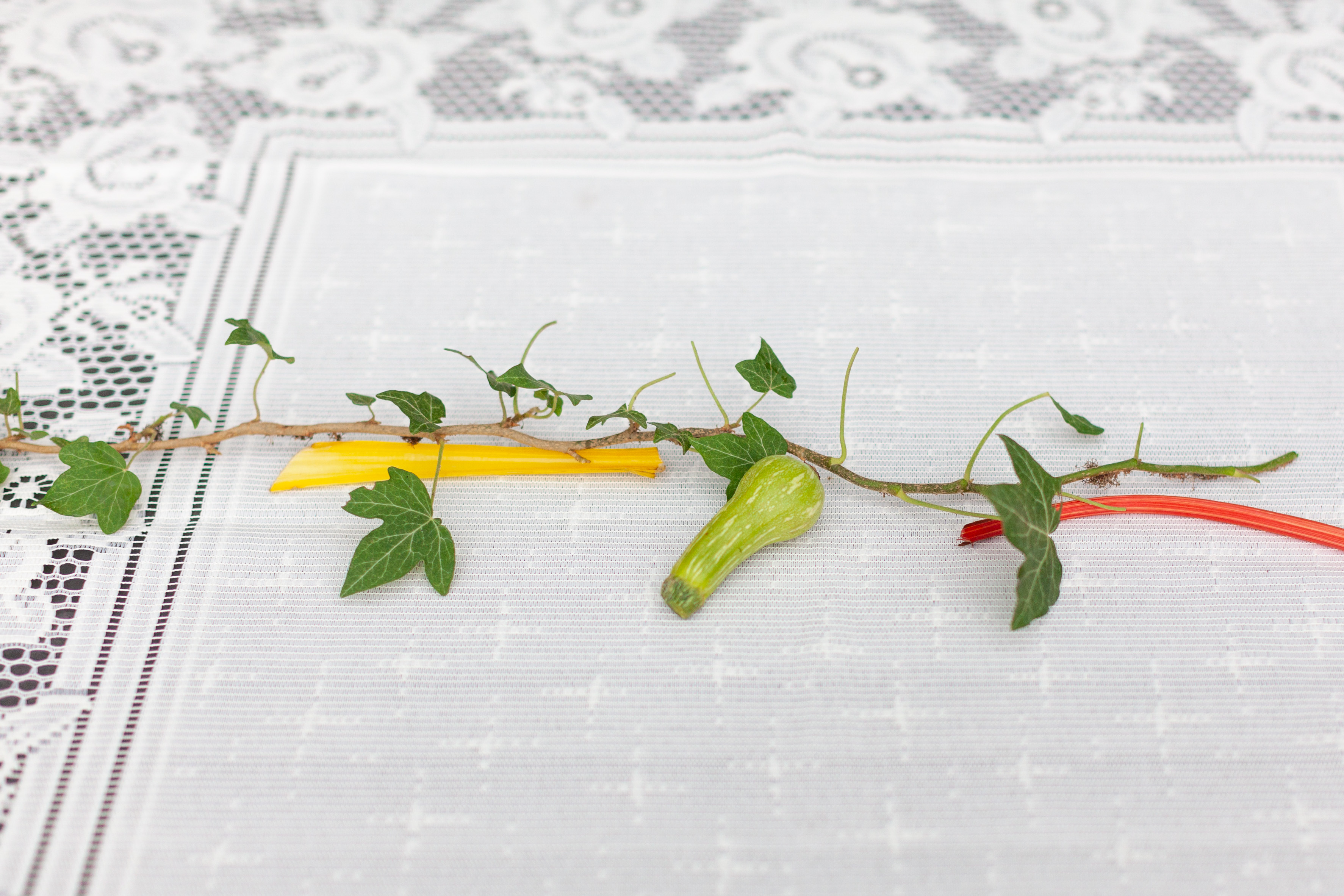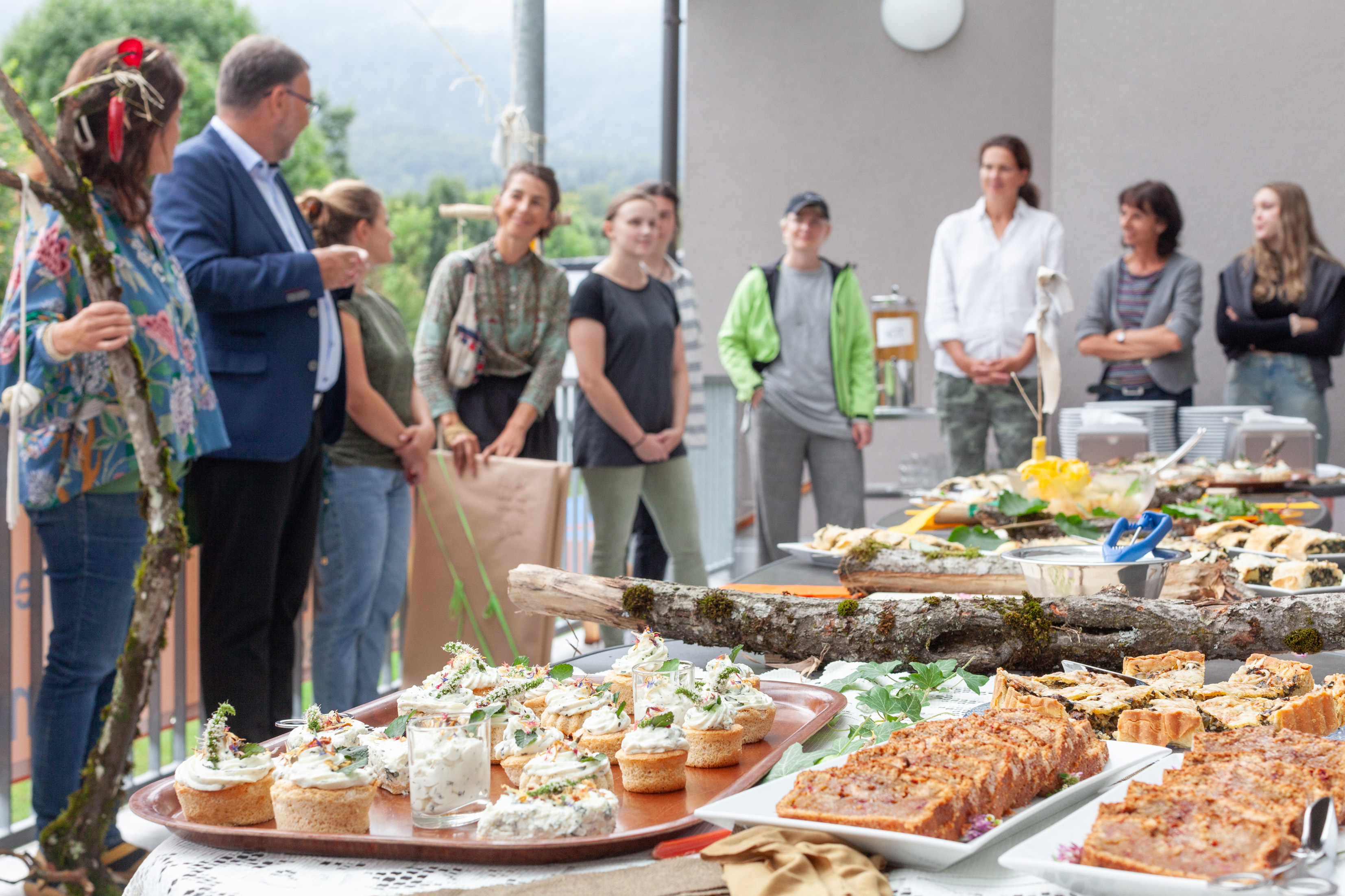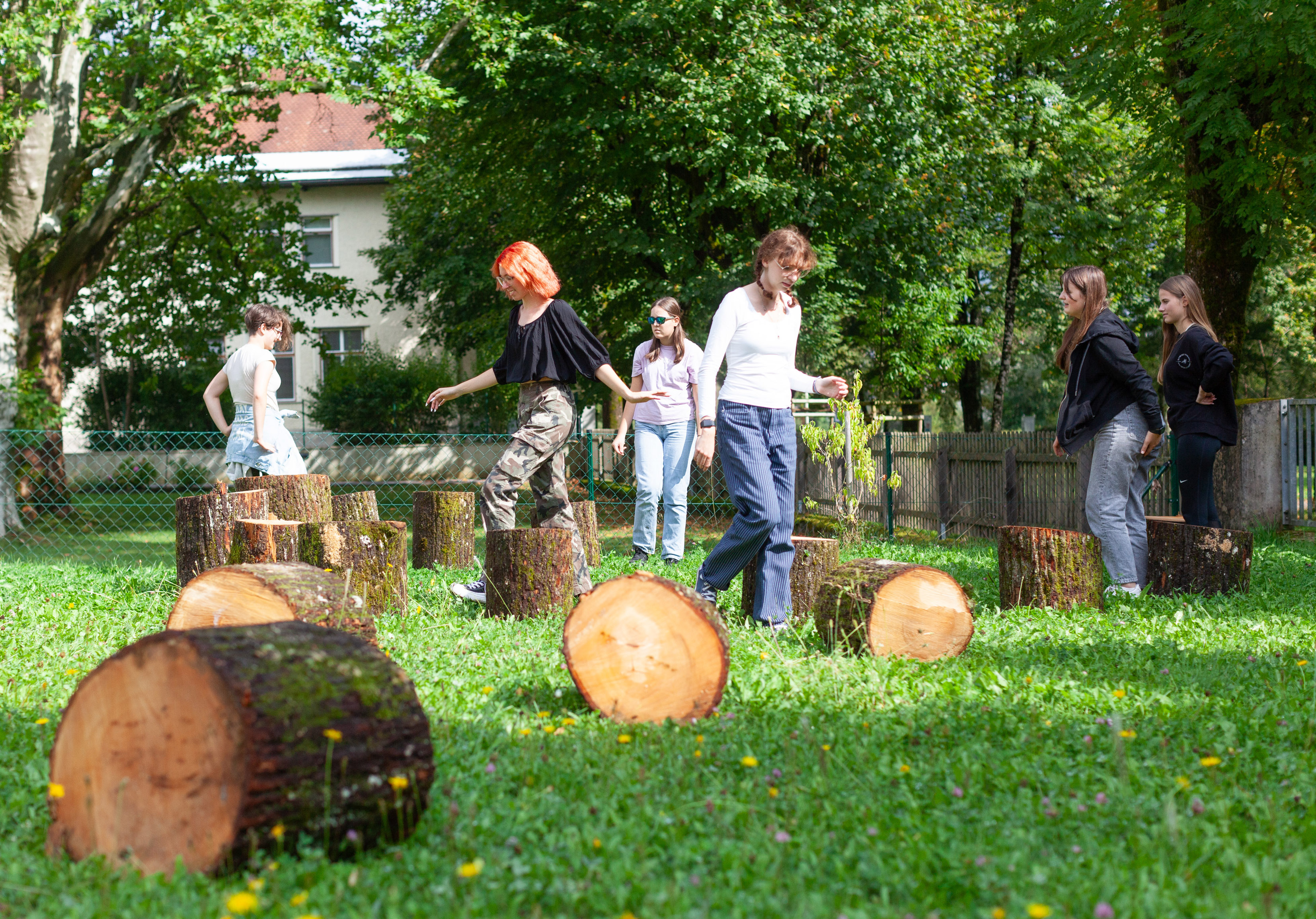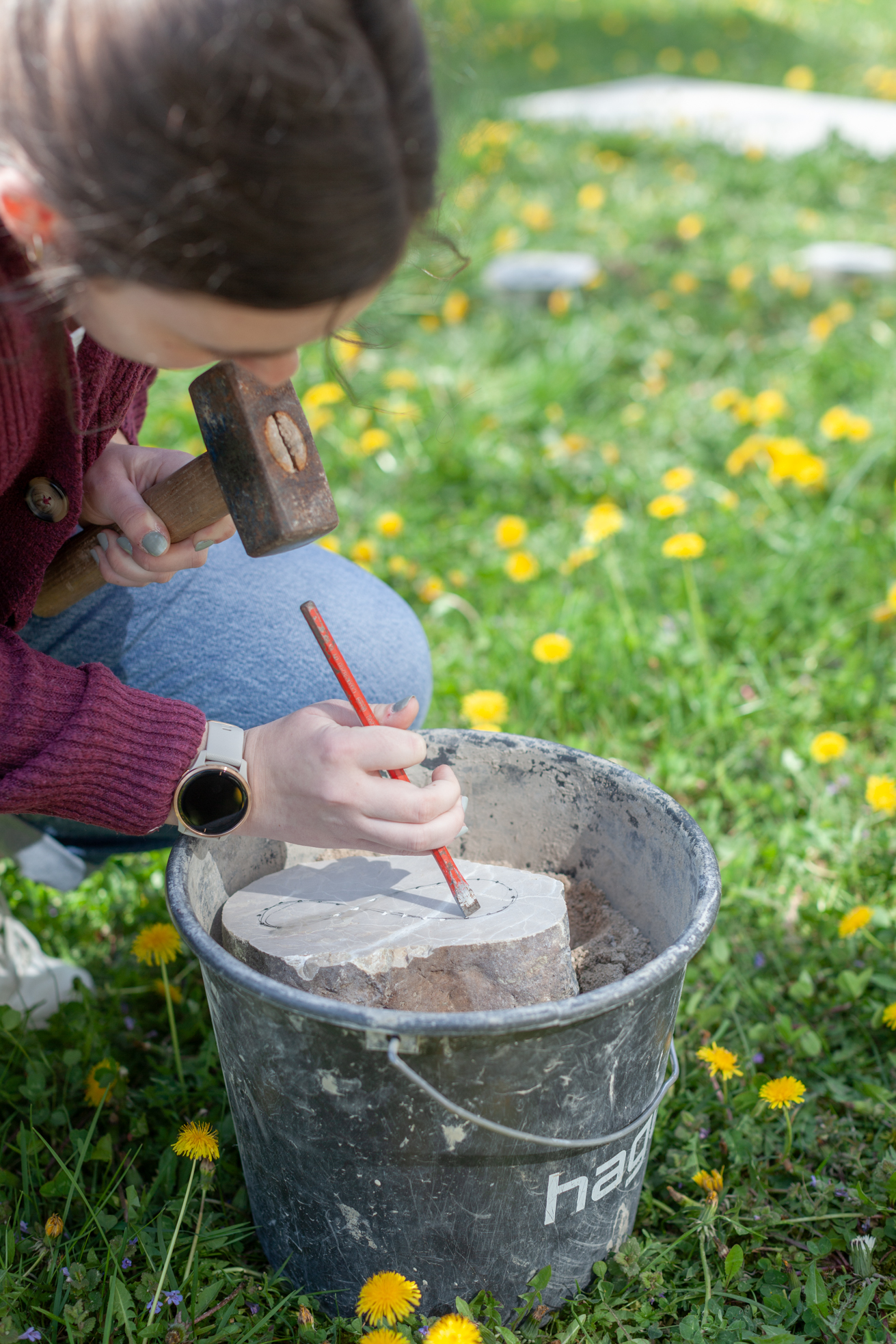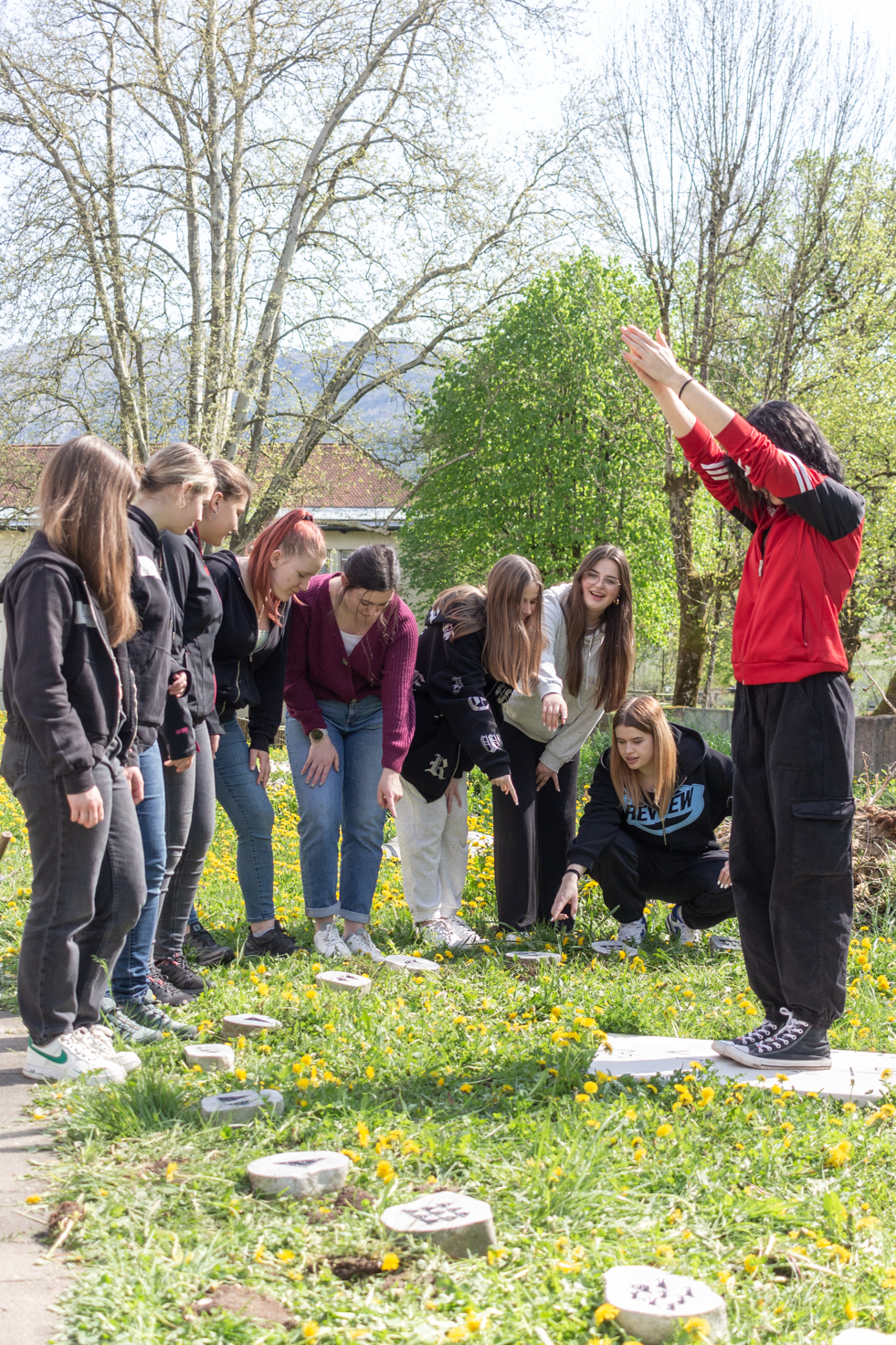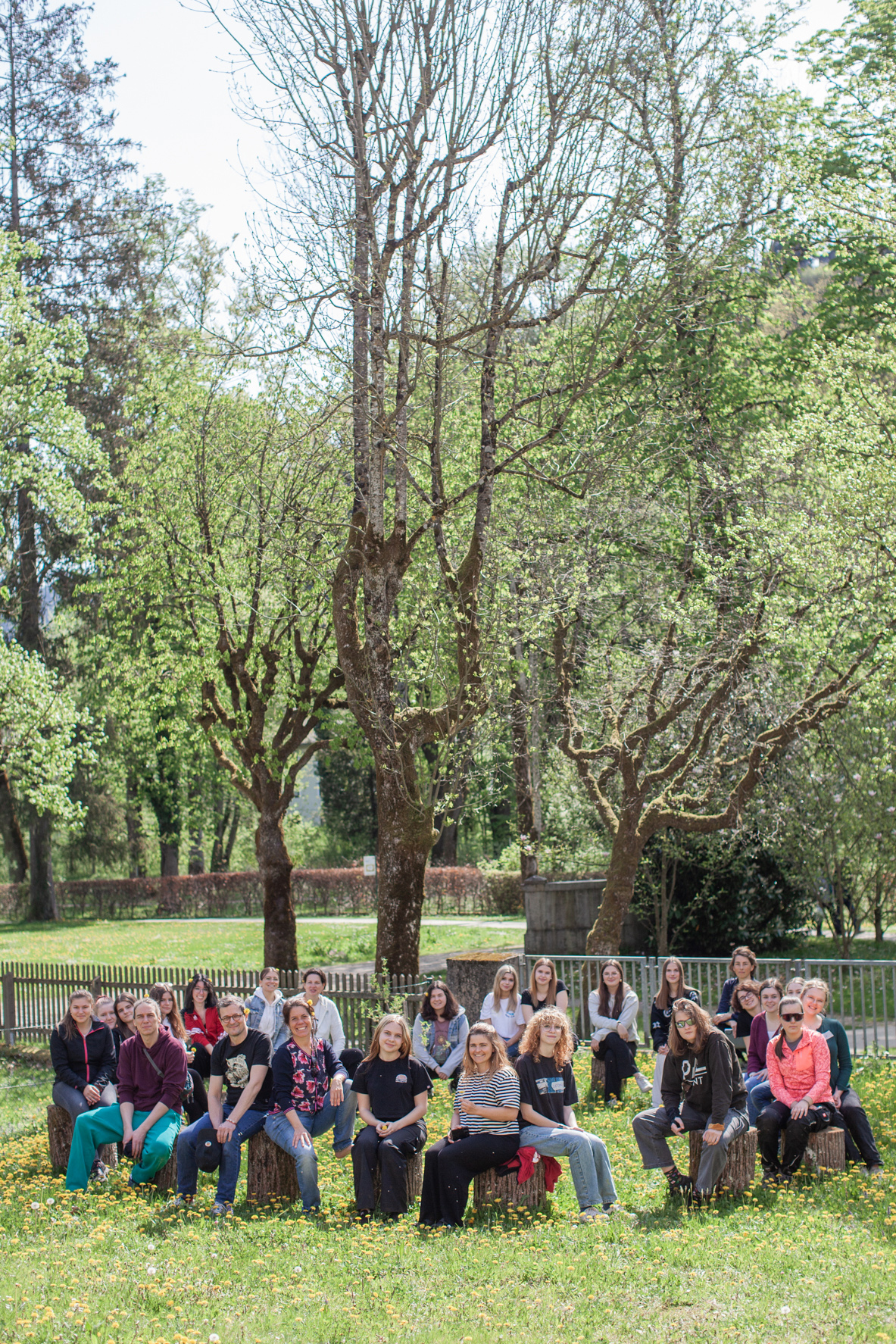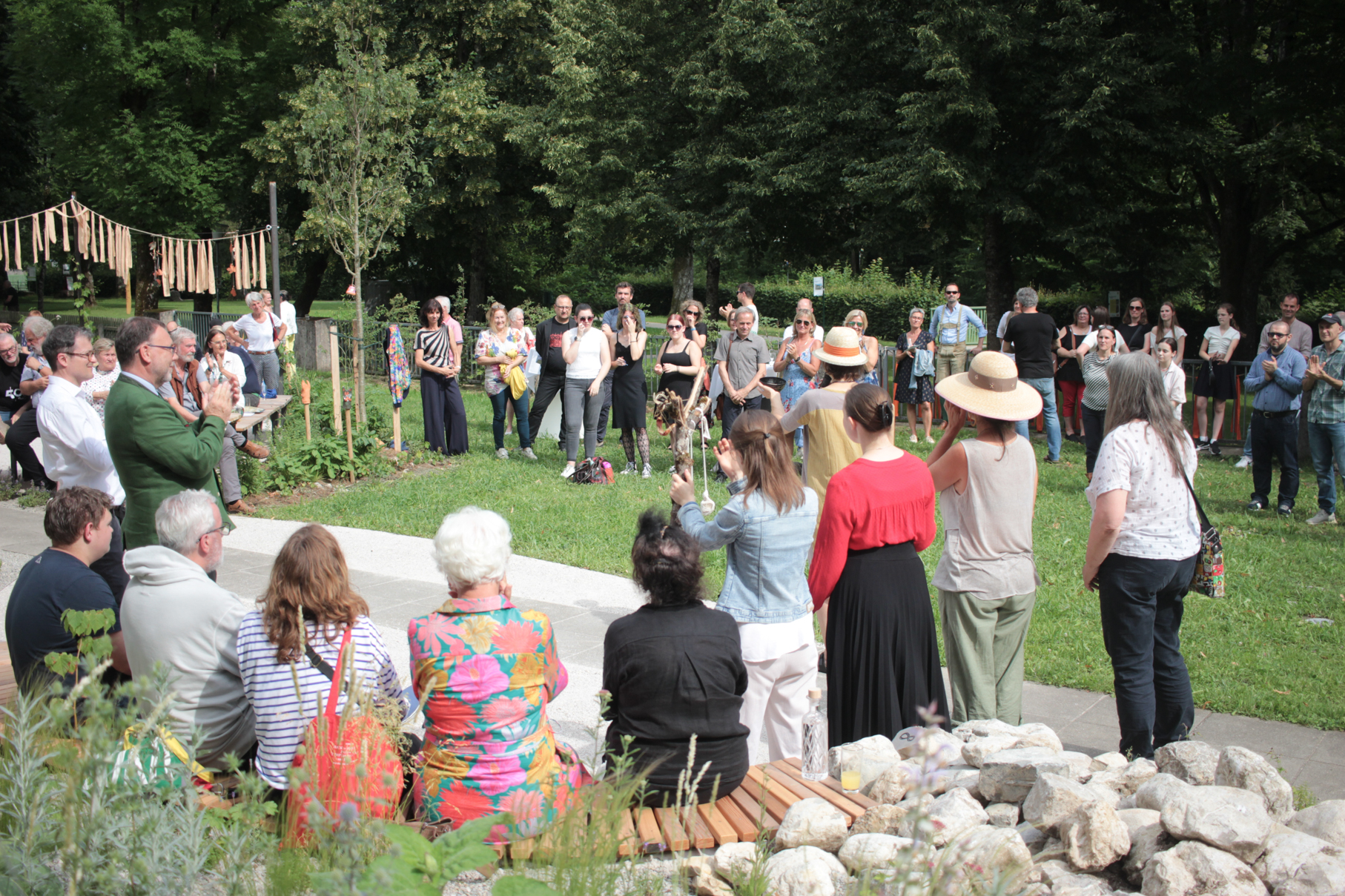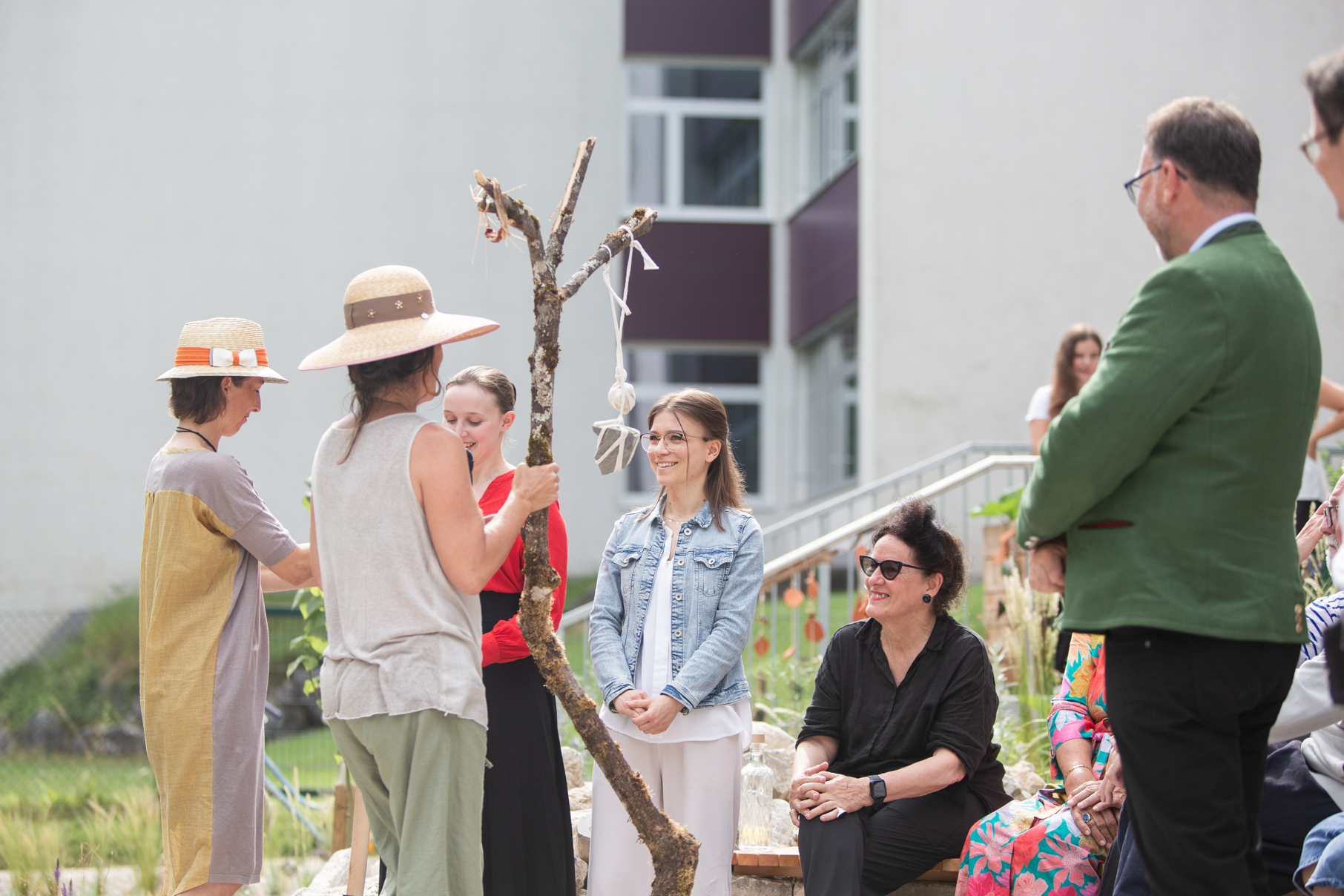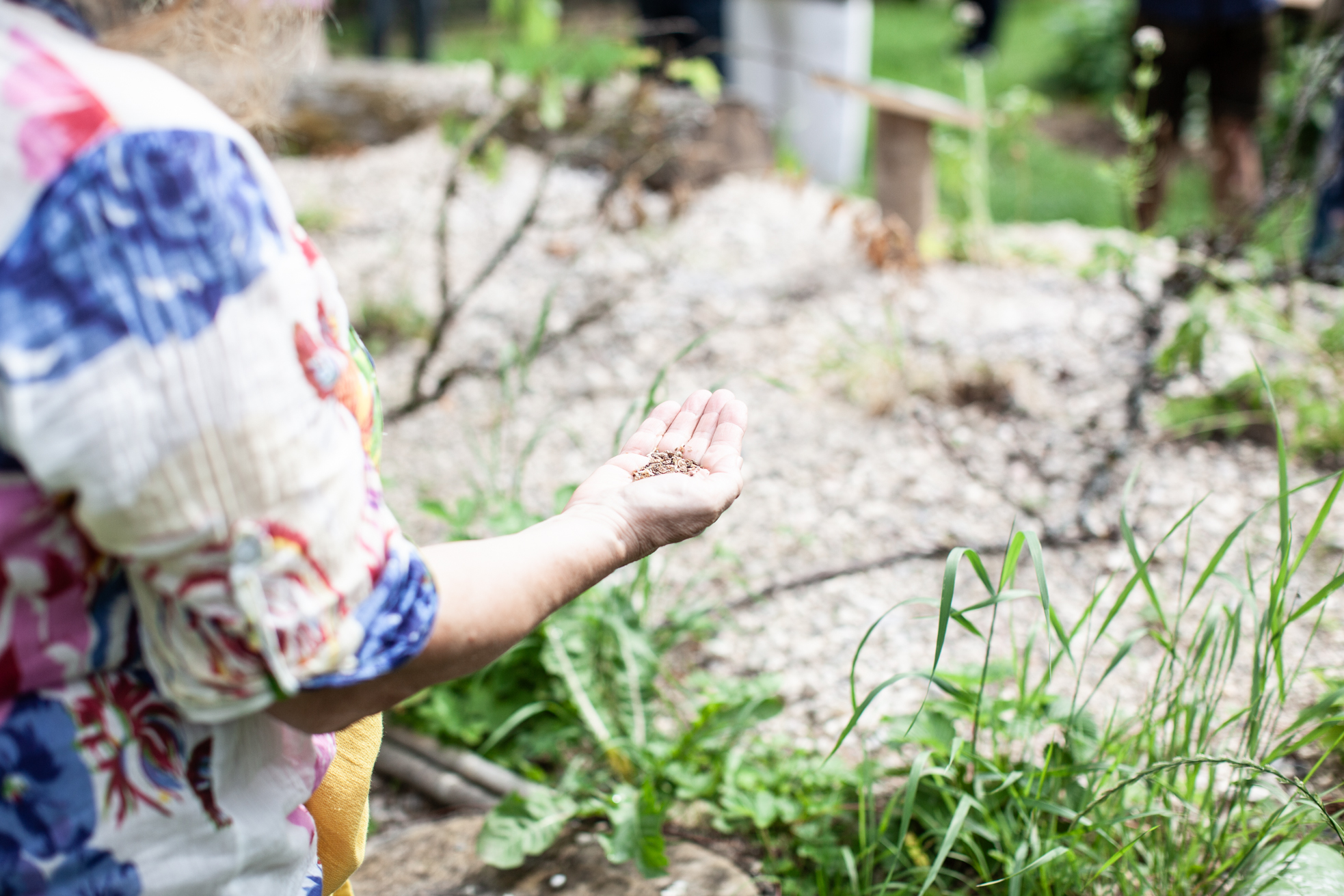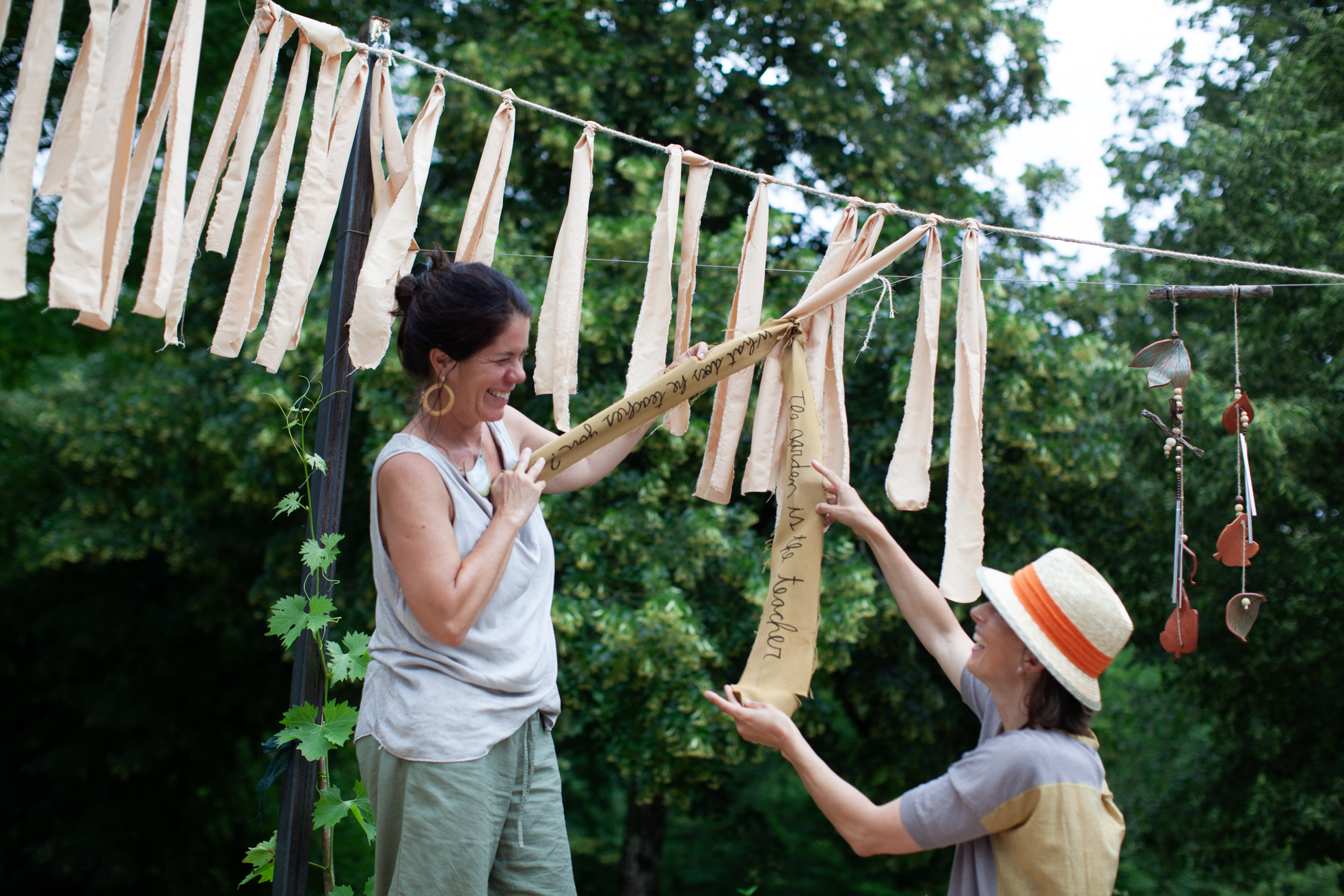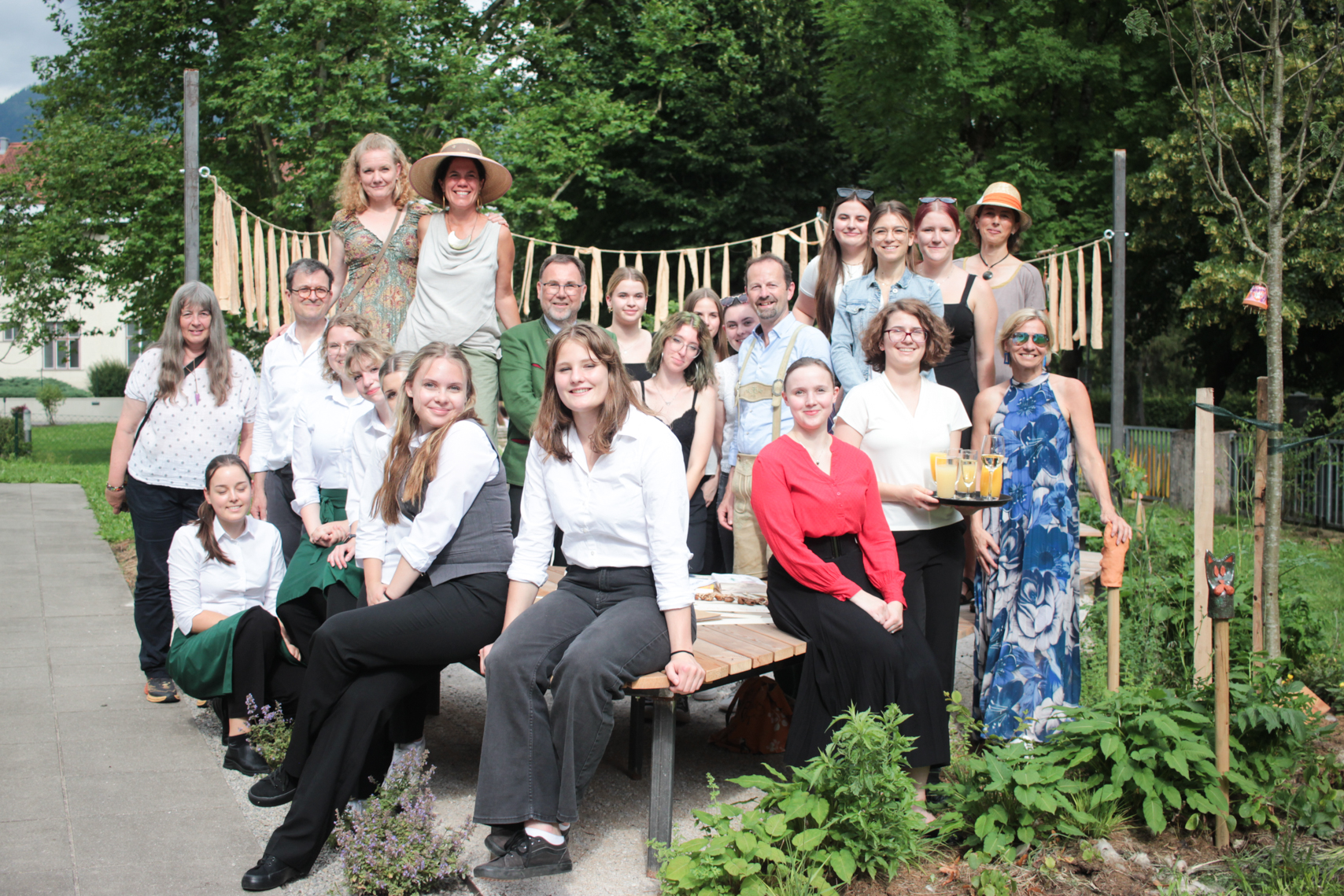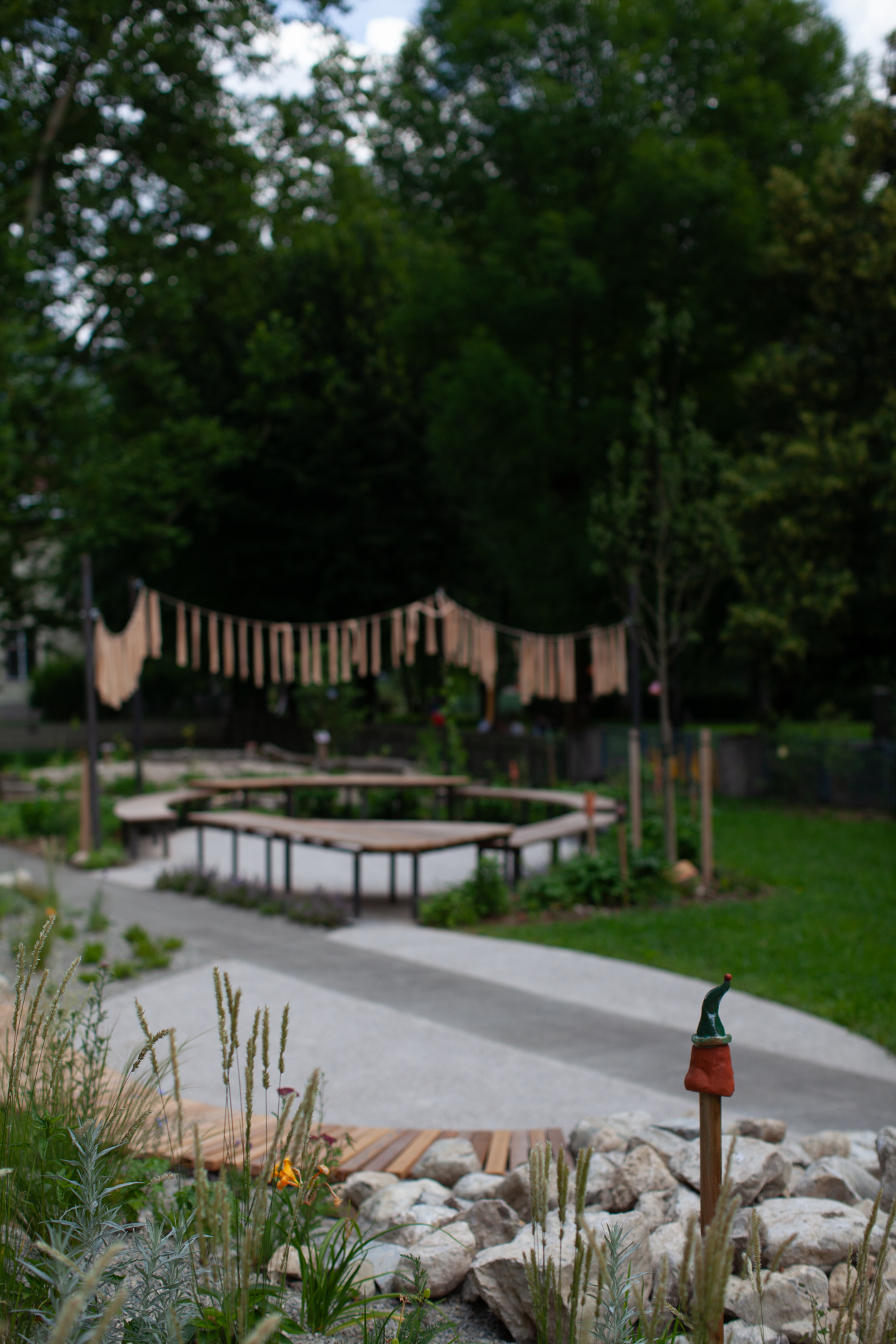Reconnecting with nature
Garden of Moving Time
Garden of Moving Time / Garten der Zeitläufe
The Garden of Moving Time is about restoring the relationship to time from social structures to cosmic dimensions. Students from a secondary school for economy, sustainability, social management and care worked with artists, teachers and various experts to design a garden on the school grounds. The participants’ visions and their presence on site became decisive for the artistic planning process. A place of biodiversity was created; nature is very welcome as teacher in the new green classroom.
Austria
Regional
Bad Ischl / Salzkammergut
It addresses urban-rural linkages
It refers to other types of transformations (soft investment)
Yes
2024-06-27
Yes
European Capital of Culture Bad Ischl Salzkammergut 2024
No
No
As a representative of an organisation, in partnership with other organisations
From a kitchen meadow to a green classroom: from 2022 to 2024, students at HLW Bad Ischl, a secondary school for economy, sustainability, social management and care, worked with artists and experts to design a garden on the school grounds. Based on the concept of care, which plays an important role in education at the HLW, the Garden of Moving Time (Garten der Zeitläufe) is about establishing the relationship to time in social structures, in nature and even in cosmic dimensions. In hands-on workshops and seasonal semester exercises, the school’s environment was first examined in detail, afterwards, design options were explored with the students on site. No classical architectural plan was used in the initial planning process; instead, students and teachers’ presences and their bodies on site were the sensitive tools to define the spaces of the future garden and outdoor classroom.
In the course of the participatory planning and implementation, which was scheduled over a period of more than two years, numerous local and regional experts joined in—as for instance an organic farmer, a soil specialist and a sundials expert.
Speaking of the sun, the main motif underlying the entire design is an analemma loop. It describes the positions of the sun in the sky throughout the year. For the Garden of Moving Time, the cosmic cycle of time was the inspiring force that significantly influences life on earth.
Caring for nature and the environment became another central principle. The materials used in the planning and horticulture were inspected for sustainability and mainly sourced regionally. The individual areas of the garden were dedicated to different agents—both human and other-than-human. Nature is welcome as teacher in the new green classroom.
A previously unused area on the school grounds was transformed into a place of biodiversity, from which the school kitchen benefits directly, and into a recreation room that is both a place to learn and a place to chill out.
In the course of the participatory planning and implementation, which was scheduled over a period of more than two years, numerous local and regional experts joined in—as for instance an organic farmer, a soil specialist and a sundials expert.
Speaking of the sun, the main motif underlying the entire design is an analemma loop. It describes the positions of the sun in the sky throughout the year. For the Garden of Moving Time, the cosmic cycle of time was the inspiring force that significantly influences life on earth.
Caring for nature and the environment became another central principle. The materials used in the planning and horticulture were inspected for sustainability and mainly sourced regionally. The individual areas of the garden were dedicated to different agents—both human and other-than-human. Nature is welcome as teacher in the new green classroom.
A previously unused area on the school grounds was transformed into a place of biodiversity, from which the school kitchen benefits directly, and into a recreation room that is both a place to learn and a place to chill out.
Learning with nature
Earth time and cosmic time
Outdoor classroom
Promoting biodiversity
Artistic pedagogies
The Garden of Moving Time was created to bring students and teachers of the HLW Bad Ischl, as well as all the garden’s visitors closer to the time cycles in nature. It is an offer to reconcile with cosmic time.
To achieve this goal, a participatory and slow planning and construction process allowed enough time to realise the project alongside natural cycles. For example, spring was used not only to analyse the quality of the existing soil, but also to grow edible plants in different manners to find out what thrives best, which natural fertiliser to use, how much to water is needed, etc. In autumn, a harvesting party and a cooking event within the regular cooking classes opened the school year.
From the beginning on, the two artists Daniela Brasil and Sophie Krier attached great importance to the use of sustainable materials, which were sourced regionally wherever possible. Thus, the larch wood used originates from the Salzkammergut region, the small stones for the sundial were collected by the pupils themselves in the nearby Kaltenbach stream. The idea of recycling was considered as well; the big stones used in the garden come from an old house that was dismantled in a neighbouring village. The regional gardening company Wildflorie used plants exclusively from local nurseries. In this framework, the Garden of Moving Time became a place of biodiversity, with zones dedicated to different life forms: e.g. insects, reptiles, rodents, microorganisms, fungi, plants—and humans.
Developed together with 10 teachers and 40 students, the project focused on care-taking, biodiversity, sustainability, and ecological literacy, etc. In the end, a gardening time for all students and classes is intended to be anchored in the curriculum and two young teachers have been assigned main caretakers of the garden. The project is pioneering in the Austrian school system and we hope other schools will open their doors to welcome nature as a teacher.
To achieve this goal, a participatory and slow planning and construction process allowed enough time to realise the project alongside natural cycles. For example, spring was used not only to analyse the quality of the existing soil, but also to grow edible plants in different manners to find out what thrives best, which natural fertiliser to use, how much to water is needed, etc. In autumn, a harvesting party and a cooking event within the regular cooking classes opened the school year.
From the beginning on, the two artists Daniela Brasil and Sophie Krier attached great importance to the use of sustainable materials, which were sourced regionally wherever possible. Thus, the larch wood used originates from the Salzkammergut region, the small stones for the sundial were collected by the pupils themselves in the nearby Kaltenbach stream. The idea of recycling was considered as well; the big stones used in the garden come from an old house that was dismantled in a neighbouring village. The regional gardening company Wildflorie used plants exclusively from local nurseries. In this framework, the Garden of Moving Time became a place of biodiversity, with zones dedicated to different life forms: e.g. insects, reptiles, rodents, microorganisms, fungi, plants—and humans.
Developed together with 10 teachers and 40 students, the project focused on care-taking, biodiversity, sustainability, and ecological literacy, etc. In the end, a gardening time for all students and classes is intended to be anchored in the curriculum and two young teachers have been assigned main caretakers of the garden. The project is pioneering in the Austrian school system and we hope other schools will open their doors to welcome nature as a teacher.
Those 40 students who were given the opportunity to participate in the planning and construction of the Garden of Moving Time will hold this experience for long. Taking part in a long-term and experimental project with international artists and a number of recognised experts as part of their school education has a special quality and depth. Learning that the human body has been understood as the basis for measuring the space and dimensioning the garden during this embodied and sensitive planning process is a very valuable experience in itself. The students and teachers were actively involved in numerous participatory modules during workshops and the construction phases of the garden. From digging and planting a raised bed for test purposes, sensorily exploring the herbal flora in the region, designing communication elements to the construction of a horizontal sundial under the guidance of a stonemason. The students were introduced to various design strategies and craft techniques, many of which are ecological gardening methods that do not use any plastic material or artificial fertilisers and rely on regional products such as sheep's wool and horse dung. The students will probably also never forget the first picnic on the school grounds by using a solar grill, completely without fossil fuels or electricity.
The artists Daniela Brasil and Sophie Krier were responsible for the final design of the area based on the participatory processes. Watching them and the likewise experienced gardening company, or even having a hand in some of the construction works, fulfilled the students with pride.
The way in which young people were involved in various phases of planning and construction is exemplary. The duration of involvement is exemplary as well, i.e. being involved from the “dreaming-phase” to the actual building and using of the garden gave the participants a deep insight into all the steps of an artistically led transdisciplinary project.
The artists Daniela Brasil and Sophie Krier were responsible for the final design of the area based on the participatory processes. Watching them and the likewise experienced gardening company, or even having a hand in some of the construction works, fulfilled the students with pride.
The way in which young people were involved in various phases of planning and construction is exemplary. The duration of involvement is exemplary as well, i.e. being involved from the “dreaming-phase” to the actual building and using of the garden gave the participants a deep insight into all the steps of an artistically led transdisciplinary project.
The design and construction of the Garden of Moving Time was structured in such a way that opportunities for active involvement were repeatedly offered. In 2022, the school management selected around 40 students from different classes to take part, and it was clear and important from the outset that they would be able to participate and experience the process until completion in 2024. Local experts and local businesses, small associations, school employees, neighbours and even elderly alumni were involved in the artistic research process, which aimed to include and connect local expertise and world views in the participatory planning process.
As the project was fully financed by contributions from the Capital of Culture 2024 Bad Ischl Salzkammergut and the Directorate of Education from Upper Austria, there were no costs for the participating students and teachers. On the contrary, the project also strengthened the culture of togetherness by providing supplies like food from the school kitchen. The cooperation between students, teachers, artists and external participants towards creating other-than-human relations and kinship was clearly noticeable in all phases of the project. Ranging from the first workshops focussing on collaboration rather than competition, to the grand opening of the Garden of Moving Time, when the students introduced the project to the guests acting as experts on their garden.
In terms of accessibility, great importance was attached during planning and construction to ensuring that as many areas of the garden as possible are easily accessible for people with restricted mobility. The redesign of a meadow area on the grounds of a public school into a garden area that can be used by students and teachers as well as by external visitors is an important contribution to the issue of accessibility and the use of public space in general. The students involved have learnt a lot about these issues and have been sensitised to accessibility issues.
As the project was fully financed by contributions from the Capital of Culture 2024 Bad Ischl Salzkammergut and the Directorate of Education from Upper Austria, there were no costs for the participating students and teachers. On the contrary, the project also strengthened the culture of togetherness by providing supplies like food from the school kitchen. The cooperation between students, teachers, artists and external participants towards creating other-than-human relations and kinship was clearly noticeable in all phases of the project. Ranging from the first workshops focussing on collaboration rather than competition, to the grand opening of the Garden of Moving Time, when the students introduced the project to the guests acting as experts on their garden.
In terms of accessibility, great importance was attached during planning and construction to ensuring that as many areas of the garden as possible are easily accessible for people with restricted mobility. The redesign of a meadow area on the grounds of a public school into a garden area that can be used by students and teachers as well as by external visitors is an important contribution to the issue of accessibility and the use of public space in general. The students involved have learnt a lot about these issues and have been sensitised to accessibility issues.
The project structure of the Garden of Moving Time was conceived as a participatory process over a period of more than two years, enabling the students involved to take part in all phases and gain an insight into various areas. And to work with renowned, internationally active artists as well as experts from fields as diverse as organic farming, sustainable horticulture, soil analysis, wood and stone construction and environmental activism. All those involved were included in the project based on their expertise, regardless of their education or social status. It should not be forgotten that the pupils are also important experts regarding the school and the surrounding public space. Their needs and views were incorporated from the very beginning, through the production of a wishes-archive.
One aspect that was added to the project in the final phase of realisation is the opening up of opportunities for people not being part of the school to get involved. This primarily refers to neighbours and people from the Bad Ischl municipality respectively the Salzkammergut region who are positively attached to the Garden of Moving Time. A separate area in the garden has been set aside for them to further expand the biodiversity with donated plants. Active citizens got involved before the garden was completed and opened, providing plants such as young lime tree shoots and seeds, but also co-creating the garden's inauguration ritual.
The approach of togetherness, cooperation and the rejection of competition and rivalry is crucial for the project and groundbreaking for other projects. It was a valuable experience to all participants to witness a horizontally conceived process in which students, teachers, artists, various experts and active citizens work together towards a common goal that benefits the community as a whole.
One aspect that was added to the project in the final phase of realisation is the opening up of opportunities for people not being part of the school to get involved. This primarily refers to neighbours and people from the Bad Ischl municipality respectively the Salzkammergut region who are positively attached to the Garden of Moving Time. A separate area in the garden has been set aside for them to further expand the biodiversity with donated plants. Active citizens got involved before the garden was completed and opened, providing plants such as young lime tree shoots and seeds, but also co-creating the garden's inauguration ritual.
The approach of togetherness, cooperation and the rejection of competition and rivalry is crucial for the project and groundbreaking for other projects. It was a valuable experience to all participants to witness a horizontally conceived process in which students, teachers, artists, various experts and active citizens work together towards a common goal that benefits the community as a whole.
The following agents were involved in the planning and construction of the Garden of Moving Time:
x) The project was initiated by six people, Birgit Lurz & Wolfgang Schlag (curators and cultural workers), Margarethe Makovec & Anton Lederer (directors of the art centre <rotor>), Rainer Posch & Karl Rossmann (director and teacher at the school HLW Bad Ischl).
x) 40 students of HLW Bad Ischl have been involved over the full project periode.
x) 10 engaged teachers and two school caretakers took actively part.
x) The two artists Daniela Brasil (based in Austria, born in Brasil) and Sophie Krier (based in The Netherlands, born in Luxembourg) conducted the project.
x) < rotor > Centre for Contemporary Art produced the project.
x) Bad Ischl Salzkammergut European Capital of Culture 2024 was the main financial supporter.
x) Directorate of Education Upper Austria became the second source of financial support.
x) The gardening company Wildflorie was responsible for the construction of the garden.
x) Blumen Eder supplied trees, shrubs and perennials, partly sponsored.
x) Austrian Federal Forests was sponsor of the larch wood used in the garden.
x) Several other local and regional experts and professionals led workshops or contributed to the planting
x) Neighbours and active citizens contributed to the project with ideas and activities.
The transdisciplinary and intergenerational mix of these people (and their organisations and companies) contributed significantly to the successful planning and implementation of the Garden of Moving Time. Everybody learned from each other: the young people—students—learned from the artists and other experts, who in turn gained an insight into the reality of life for students at a secondary school in an Austrian region in the midst of the Alps. Everyone learned from the garden itself, and will keep on gathering knowledge and acting responsibly as the project continues in some way: a garden evolves and needs care over time.
x) The project was initiated by six people, Birgit Lurz & Wolfgang Schlag (curators and cultural workers), Margarethe Makovec & Anton Lederer (directors of the art centre <rotor>), Rainer Posch & Karl Rossmann (director and teacher at the school HLW Bad Ischl).
x) 40 students of HLW Bad Ischl have been involved over the full project periode.
x) 10 engaged teachers and two school caretakers took actively part.
x) The two artists Daniela Brasil (based in Austria, born in Brasil) and Sophie Krier (based in The Netherlands, born in Luxembourg) conducted the project.
x) < rotor > Centre for Contemporary Art produced the project.
x) Bad Ischl Salzkammergut European Capital of Culture 2024 was the main financial supporter.
x) Directorate of Education Upper Austria became the second source of financial support.
x) The gardening company Wildflorie was responsible for the construction of the garden.
x) Blumen Eder supplied trees, shrubs and perennials, partly sponsored.
x) Austrian Federal Forests was sponsor of the larch wood used in the garden.
x) Several other local and regional experts and professionals led workshops or contributed to the planting
x) Neighbours and active citizens contributed to the project with ideas and activities.
The transdisciplinary and intergenerational mix of these people (and their organisations and companies) contributed significantly to the successful planning and implementation of the Garden of Moving Time. Everybody learned from each other: the young people—students—learned from the artists and other experts, who in turn gained an insight into the reality of life for students at a secondary school in an Austrian region in the midst of the Alps. Everyone learned from the garden itself, and will keep on gathering knowledge and acting responsibly as the project continues in some way: a garden evolves and needs care over time.
The conception and realisation of the Garden of Moving Time involved a large number of people from very different fields of knowledge and professions.
The two artists Daniela Brasil and Sophie Krier, who had the overall artistic direction have a large experience in participatory and relational practices and projects in public and social spaces. Ten teachers from the HLW Bad Ischl contributed their expertise in the subjects of natural science, religion/ethics, cookery and nutrition, sports, visual arts and crafts. 40 pupils were involved as experts on their school and in the region, as many of them come from the surrounding villages. Experts were invited to support the workshops: an organic farmer, a carpenter, an artist and social worker from the youth sector, a horticulturist and social worker, a soil specialist and a stonemason. The gardening company Wildflorie was brought in for the realisation of the garden, collaborating with specialists in stone construction, wood work and welding. Some modules of the garden, such as the raised beds, the garden hut or insect hotels and signage as well as clay bird baths and other clay objects were built by the students themselves.
Regionally compatible plants—trees, shrubs, perennials—were supplied by a local nursery.
The Austrian Federal Forests supplied the larch wood used, which had previously been cut to size in a regional sawmill.
The great added value of the project lies in the fact that local and regional expertise was combined with international experience (especially that of the artists). Emphasis was placed on sustainable regional products, environmental compatibility and, where appropriate, recycling.
The students involved (and also the teachers) came into contact with various experts and professionals during the planning and realisation and actively participated in many phases of the project and gained a lot of new experience. But they also contributed their own knowledge and skills!
The two artists Daniela Brasil and Sophie Krier, who had the overall artistic direction have a large experience in participatory and relational practices and projects in public and social spaces. Ten teachers from the HLW Bad Ischl contributed their expertise in the subjects of natural science, religion/ethics, cookery and nutrition, sports, visual arts and crafts. 40 pupils were involved as experts on their school and in the region, as many of them come from the surrounding villages. Experts were invited to support the workshops: an organic farmer, a carpenter, an artist and social worker from the youth sector, a horticulturist and social worker, a soil specialist and a stonemason. The gardening company Wildflorie was brought in for the realisation of the garden, collaborating with specialists in stone construction, wood work and welding. Some modules of the garden, such as the raised beds, the garden hut or insect hotels and signage as well as clay bird baths and other clay objects were built by the students themselves.
Regionally compatible plants—trees, shrubs, perennials—were supplied by a local nursery.
The Austrian Federal Forests supplied the larch wood used, which had previously been cut to size in a regional sawmill.
The great added value of the project lies in the fact that local and regional expertise was combined with international experience (especially that of the artists). Emphasis was placed on sustainable regional products, environmental compatibility and, where appropriate, recycling.
The students involved (and also the teachers) came into contact with various experts and professionals during the planning and realisation and actively participated in many phases of the project and gained a lot of new experience. But they also contributed their own knowledge and skills!
A central idea in the participatory planning and construction of the Garden of Moving Times was to develop and implement an organic process that would unfold along the logics of the school's curriculum and respond to the school's teaching content and focus.
What was particularly unusual in the context of the Austrian school system was the time span. Not only was the entire garden project ultimately focussed on the aspect of time—from the individual time experience of a student to cosmic time—in addition, over a period of more than two years, the project was able to propose a regenerative approach that aligns with the seasonal and life cycles of nature.
The project pursued a holistic approach that emphasised the importance of considering all forms of life that can be found on a school campus, human and other-than-human agents in the local environment. Another ambition was to involve as many stakeholders as possible from different fields of knowledge and subjects. In order to enable the transfer of knowledge from experts to students, but also vice versa, because the project saw the students as co-creators: indispensable experts in their school and their daily environment.
Not only advocating but also implementing biodiversity at large is very unusual at an Austrian public school. The open spaces around the schools are almost simply subject to questions of easy maintenance. This means that there are few meadows or garden areas where flora and fauna are enabled to flourish and where the desire for biodiversity is evident. By making a clear statement in favour of a nature-oriented approach and biodiversity, the Garden of Moving Time is a pioneering project in this respect on school grounds. In this way, the artistic and holistic world views of this garden reach generations of young people—a valuable investment in the future.
What was particularly unusual in the context of the Austrian school system was the time span. Not only was the entire garden project ultimately focussed on the aspect of time—from the individual time experience of a student to cosmic time—in addition, over a period of more than two years, the project was able to propose a regenerative approach that aligns with the seasonal and life cycles of nature.
The project pursued a holistic approach that emphasised the importance of considering all forms of life that can be found on a school campus, human and other-than-human agents in the local environment. Another ambition was to involve as many stakeholders as possible from different fields of knowledge and subjects. In order to enable the transfer of knowledge from experts to students, but also vice versa, because the project saw the students as co-creators: indispensable experts in their school and their daily environment.
Not only advocating but also implementing biodiversity at large is very unusual at an Austrian public school. The open spaces around the schools are almost simply subject to questions of easy maintenance. This means that there are few meadows or garden areas where flora and fauna are enabled to flourish and where the desire for biodiversity is evident. By making a clear statement in favour of a nature-oriented approach and biodiversity, the Garden of Moving Time is a pioneering project in this respect on school grounds. In this way, the artistic and holistic world views of this garden reach generations of young people—a valuable investment in the future.
The basic project structure was developed by the art centre <rotor> together with two cultural workers based in Bad Ischl, the director of the school and a teacher who first had the vision for a garden on the school grounds. The project was designed in such a way that a group of 40 students and a team of teachers could be actively involved in all phases of the artistic design and construction. All this with a long-term perspective of more than two years, which exceeded the semester divisions for schools.
Two experienced artists, Daniela Brasil and Sophie Krier, were engaged for the project. They developed a modular system of workshops, exercises and tasks for the students, which were implemented in consultation with teachers and several external experts. The aim was to develop the project modules in line with the school's curriculum, but at the same time to go beyond, to open up spaces to think-feel with the Earth, by addressing themes such as the cycles of life, multispecies discourse, holistic, embodied and situated forms of learning.
The artists took a particularly unusual approach when planning the future garden. First, they explored the dedicated area, focusing on the body experience of students and teachers outdoors. The future garden’s dimensions were defined through embodied exercises on site, and through the observation of climate conditions affecting the plot of land throughout the different seasons. Once all participants had gained an understanding of the space, the artists worked with the students and teachers on their ideas and visions for the future garden. These were then incorporated into the detailed planning.
The participatory artistic-pedagogic approach was also applied during the construction, with the students building some of the garden and outdoor classroom elements with their own hands under the guidance of craftspeople and other experts. The students were also involved in the ceremonial opening of the garden, and acted as garden guides.
Two experienced artists, Daniela Brasil and Sophie Krier, were engaged for the project. They developed a modular system of workshops, exercises and tasks for the students, which were implemented in consultation with teachers and several external experts. The aim was to develop the project modules in line with the school's curriculum, but at the same time to go beyond, to open up spaces to think-feel with the Earth, by addressing themes such as the cycles of life, multispecies discourse, holistic, embodied and situated forms of learning.
The artists took a particularly unusual approach when planning the future garden. First, they explored the dedicated area, focusing on the body experience of students and teachers outdoors. The future garden’s dimensions were defined through embodied exercises on site, and through the observation of climate conditions affecting the plot of land throughout the different seasons. Once all participants had gained an understanding of the space, the artists worked with the students and teachers on their ideas and visions for the future garden. These were then incorporated into the detailed planning.
The participatory artistic-pedagogic approach was also applied during the construction, with the students building some of the garden and outdoor classroom elements with their own hands under the guidance of craftspeople and other experts. The students were also involved in the ceremonial opening of the garden, and acted as garden guides.
The Garden of Moving Time will inspire other schools to think about the advantages and qualities of an outdoor classroom and, in the best case scenario, to set one up at their school. This applies to the Austrian context but also beyond.
When planning such a garden in educational context, it can be very inspiring to incorporate the cycles and processes of nature into a school's lessons, to understand nature as a teacher, enabling hand-on and lively experience to the students.
The use of artistic practices and participatory methods from art and culture opens up possibilities within the limitations of the education system that are otherwise not easy to realise in regular operations. Especially when the planning and construction process is developed in line with the school curriculum. Numerous school subjects such as natural history, religion / ethics, philosophy, art education and handicrafts—and at a school type such as the HLW Bad Ischl: gastronomy education, food science and sustainability—are suitable for this.
Overall, it can be said that the process of developing and realising the garden is a great learning process for everyone involved—students and teachers, artists and experts. Once the garden has been created, the learning factor does not stop, on the contrary. A garden is constantly growing and changing, it needs attention and care so that it can thrive, and even more so if you want to grow and harvest vegetables, fruit and herbs. Students and teachers who do not only use the garden as a learning space within the curriculum, but are also entrusted with its care, gain important experience in terms of dealing with biodiversity, sustainability and responsability.
When planning such a garden in educational context, it can be very inspiring to incorporate the cycles and processes of nature into a school's lessons, to understand nature as a teacher, enabling hand-on and lively experience to the students.
The use of artistic practices and participatory methods from art and culture opens up possibilities within the limitations of the education system that are otherwise not easy to realise in regular operations. Especially when the planning and construction process is developed in line with the school curriculum. Numerous school subjects such as natural history, religion / ethics, philosophy, art education and handicrafts—and at a school type such as the HLW Bad Ischl: gastronomy education, food science and sustainability—are suitable for this.
Overall, it can be said that the process of developing and realising the garden is a great learning process for everyone involved—students and teachers, artists and experts. Once the garden has been created, the learning factor does not stop, on the contrary. A garden is constantly growing and changing, it needs attention and care so that it can thrive, and even more so if you want to grow and harvest vegetables, fruit and herbs. Students and teachers who do not only use the garden as a learning space within the curriculum, but are also entrusted with its care, gain important experience in terms of dealing with biodiversity, sustainability and responsability.
We are living in times of climate change; global warming can be felt in many parts of the world and is already having serious consequences for people's lives. At the same time we are also experiencing a biodiversity crisis. New species are emerging in the course of ongoing evolution, but many more species are dying out. The balance is negative and biodiversity is shrinking at an increasing rate.
The Garden of Moving Time focuses on the cycles of nature. On the time of an apple tree, a dandelion flower, a rosemary herb, the time of bees, lizards and woodpeckers. And on the time of individual human perception, and all of this in the context of our solar system and cosmic cycles. This garden is also about the coexistence of humans with all other life forms. It is about ecological literacy: raising awareness of sustainable living, of our ecological footprints, of climate change and the biodiversity crisis. The garden strengthens local biodiversity and by utilising the possibilities of the school grounds, creating a small oasis of plurality. Regionally familiar and proven plants are used, some of which have fallen into oblivion and have been brought back into the limelight. The aim is to emphasise which plants, animals and other life forms such as fungi, lichens and microorganisms thrive and develop well in the specific climatic environment of the location in the Salzkammergut, a region in the Alps.
The focus on the sun—the solar cycle sign analemma is the element on which the garden design is based—is intended to question anthropocentric world views, to reformulate the interconnectedness of our personal to planetary metabolisms, and also to foster the view of alternative energies at the centre, as is the case with solar energy. Experimental instruments such as a solar grill or the installation of a horizontal sundial, whose pointer is the interacting human body, create additional awareness of the sun and the cosmic dimension of the garden.
The Garden of Moving Time focuses on the cycles of nature. On the time of an apple tree, a dandelion flower, a rosemary herb, the time of bees, lizards and woodpeckers. And on the time of individual human perception, and all of this in the context of our solar system and cosmic cycles. This garden is also about the coexistence of humans with all other life forms. It is about ecological literacy: raising awareness of sustainable living, of our ecological footprints, of climate change and the biodiversity crisis. The garden strengthens local biodiversity and by utilising the possibilities of the school grounds, creating a small oasis of plurality. Regionally familiar and proven plants are used, some of which have fallen into oblivion and have been brought back into the limelight. The aim is to emphasise which plants, animals and other life forms such as fungi, lichens and microorganisms thrive and develop well in the specific climatic environment of the location in the Salzkammergut, a region in the Alps.
The focus on the sun—the solar cycle sign analemma is the element on which the garden design is based—is intended to question anthropocentric world views, to reformulate the interconnectedness of our personal to planetary metabolisms, and also to foster the view of alternative energies at the centre, as is the case with solar energy. Experimental instruments such as a solar grill or the installation of a horizontal sundial, whose pointer is the interacting human body, create additional awareness of the sun and the cosmic dimension of the garden.
The Garden of Moving Time is focussed on a return to the cycles of nature. The seasons that determine the appearance of a garden, the different times during the day and the associated light and shade situation, the observation of the growth of trees and shrubs, flowers and herbs, and the time spent in the garden for learning, chilling out and caring for the garden—all of this strengthens the connection to nature and creates community too. Community with other students, with teachers and all friends and visitors of the garden. Not to mention all the other-than-human agents!
For the HLW Bad Ischl, an additional space was created on the school grounds to be used in many different ways. As a learning space—an open-air classroom for fresh air and letting nature be the teacher. The school community is enabled to develop a different, more relaxed relationship with time than in regular school life, due to exam stress, strict school hours, etc. In the garden, one can learn that cosmic time and atmospheric conditions influence our lives and are above everything.
Apart from that, an open space has been created to be used as a lounge and break room—to meet, chill out and to celebrate. It's also a space for having snacks and lunch, just take a seat on the newly built seating areas. Or grab a picnic blanket and relay in a hammock, a place to be and to think-feel with the earth. Potentially also a space for cooking—an open-air kitchen is to be built in a follow-up project.
By growing herbs, vegetables and fruit in front of the school kitchen, the garden has an impact on the school menu. It moved from frozen parsley and chives, to edible meadow flowers and freshly harvested herbs. Ultimately, however, a public space has been created that breaks down the barriers between the school and its neighbourhood. In this way, the Garden of Moving Time promotes something that we urgently need in times of narcissism present in politics and business: cultivated togetherness and solidarity.
For the HLW Bad Ischl, an additional space was created on the school grounds to be used in many different ways. As a learning space—an open-air classroom for fresh air and letting nature be the teacher. The school community is enabled to develop a different, more relaxed relationship with time than in regular school life, due to exam stress, strict school hours, etc. In the garden, one can learn that cosmic time and atmospheric conditions influence our lives and are above everything.
Apart from that, an open space has been created to be used as a lounge and break room—to meet, chill out and to celebrate. It's also a space for having snacks and lunch, just take a seat on the newly built seating areas. Or grab a picnic blanket and relay in a hammock, a place to be and to think-feel with the earth. Potentially also a space for cooking—an open-air kitchen is to be built in a follow-up project.
By growing herbs, vegetables and fruit in front of the school kitchen, the garden has an impact on the school menu. It moved from frozen parsley and chives, to edible meadow flowers and freshly harvested herbs. Ultimately, however, a public space has been created that breaks down the barriers between the school and its neighbourhood. In this way, the Garden of Moving Time promotes something that we urgently need in times of narcissism present in politics and business: cultivated togetherness and solidarity.

